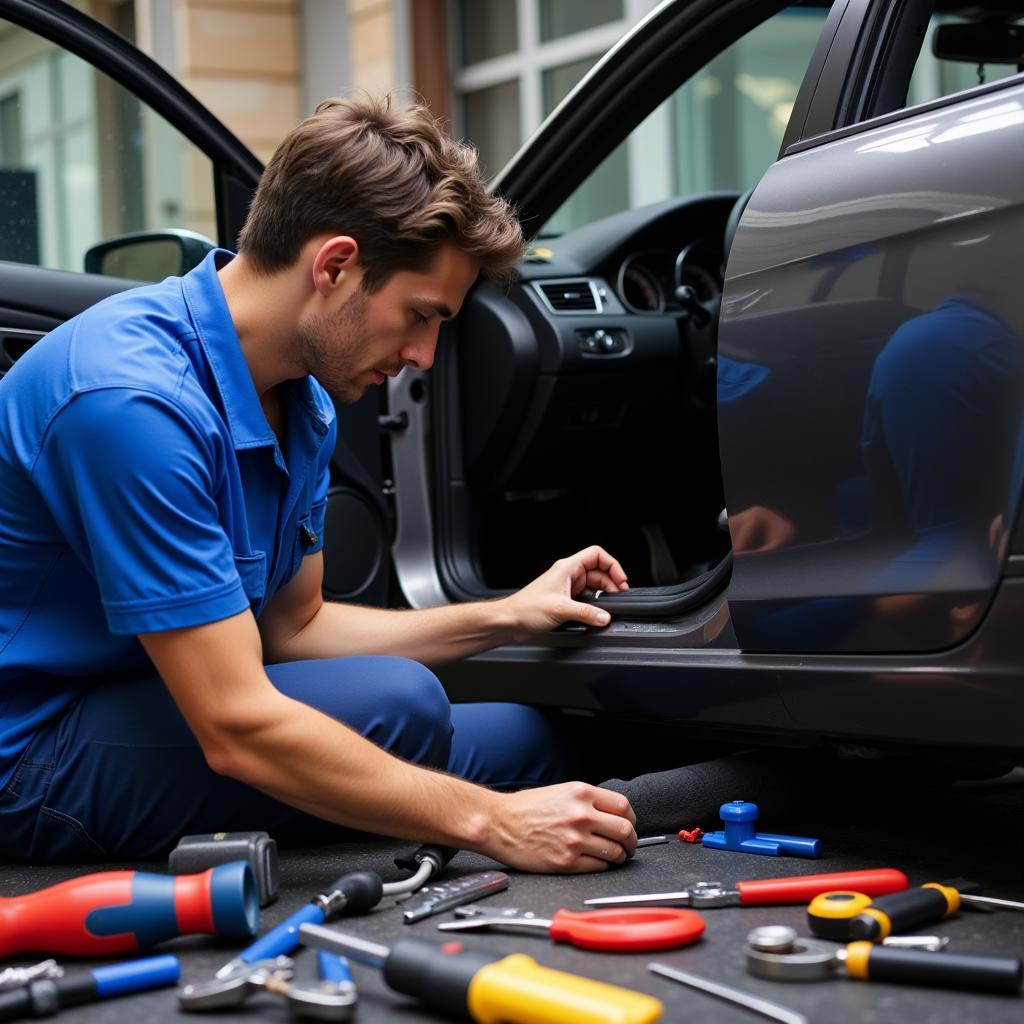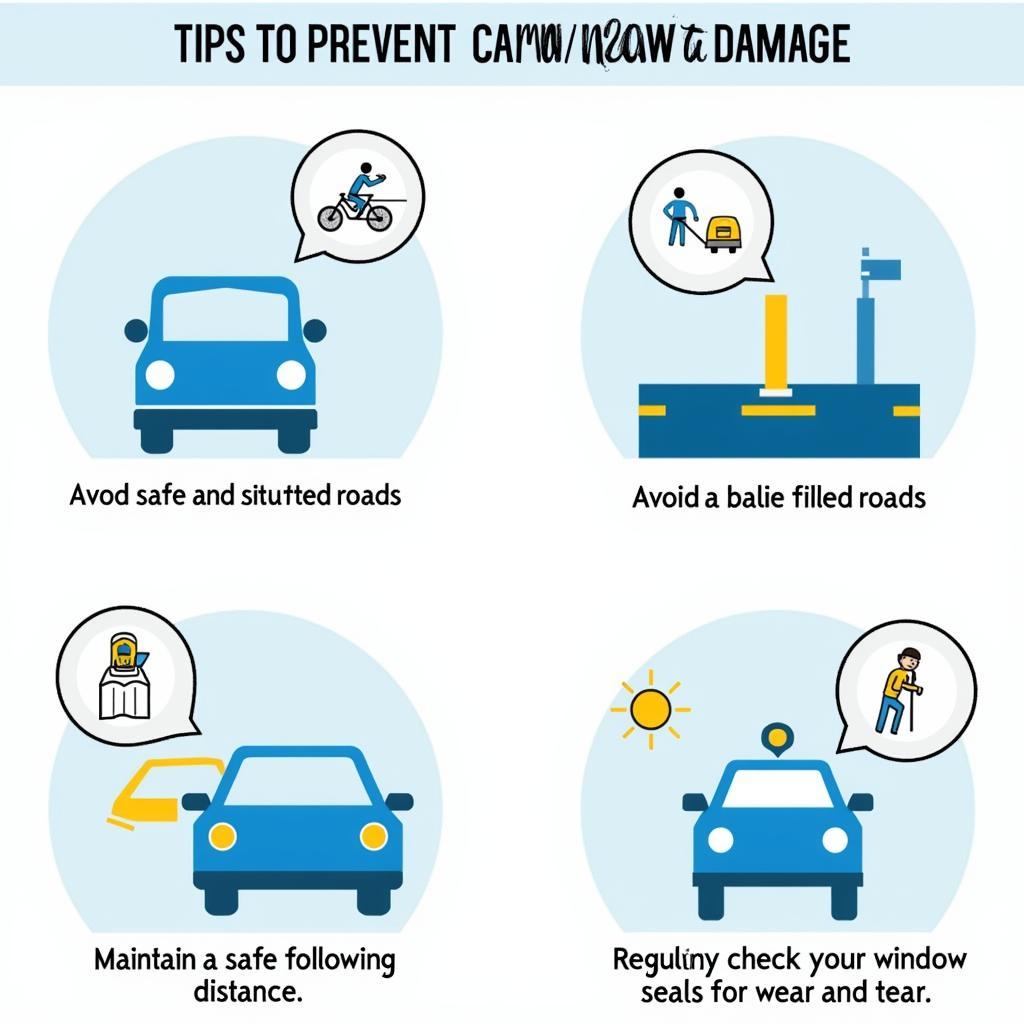Car window linings, those rubber seals around your car windows, play a crucial role in keeping your car’s interior comfortable and protected from the elements. Over time, these linings can deteriorate, crack, or tear, leading to wind noise, water leaks, and even potential damage to your car’s interior. This comprehensive guide delves into the importance of Car Window Lining Repair, common problems, DIY solutions, and when to seek professional help.
Understanding Car Window Linings
Car window linings, also known as weatherstripping or window seals, are typically made of rubber or a combination of rubber and plastic. They create a tight seal between the window and the car body, serving several important functions:
- Preventing Water Leaks: The lining acts as a barrier, preventing rainwater and car washes from seeping into your vehicle’s interior.
- Reducing Wind Noise: A tight seal minimizes wind noise, providing a quieter and more pleasant driving experience.
- Protecting the Window: The lining cushions the window as it rolls up and down, preventing scratches and damage.
- Insulation: Window linings help maintain the effectiveness of your car’s heating and cooling system by sealing gaps that could allow air to escape.
Common Car Window Lining Problems
Over time, exposure to sunlight, heat, cold, moisture, and general wear and tear can cause car window linings to deteriorate. Common problems include:
- Cracking and Tearing: Rubber can become brittle and crack, especially in extreme temperatures.
- Shrinking or Hardening: The lining may shrink or harden, losing its flexibility and ability to seal properly.
- Detachment: The adhesive holding the lining in place can weaken, causing it to detach from the window or car body.
- Mold and Mildew: Moisture trapped between the lining and the window can lead to mold and mildew growth.
DIY Car Window Lining Repair
car door manual window repair is often possible for minor damage. Here’s a step-by-step guide:
- Clean the Area: Thoroughly clean the damaged lining and surrounding area with soap and water, removing dirt, debris, and any loose rubber.
- Apply Rubber Sealant: Choose a high-quality rubber sealant specifically designed for automotive weatherstripping. Apply a thin, even layer to the damaged area or the back of the detached lining.
- Press and Secure: Press the lining firmly into place, ensuring good contact with the sealant. Use masking tape to hold it in place while the sealant cures.
- Allow to Dry: Allow the sealant to dry completely according to the manufacturer’s instructions.
- Test the Seal: Once dry, test the seal by closing the window and checking for any drafts or gaps.
When to Seek Professional Help
While DIY repairs can be effective for minor damage, it’s essential to recognize when to seek professional help for manual car window mechanism repair:
- Extensive Damage: If the lining is severely damaged, cracked, or torn beyond repair, it’s best to have it replaced professionally.
- Complex Repairs: Some repairs, like replacing the lining on a power window, may require specialized tools and knowledge.
- Underlying Issues: If you suspect underlying problems with the window mechanism or door frame, a mechanic can diagnose and address these issues.
Preventing Car Window Lining Damage
Preventing damage is always better than repair. Here are some tips to prolong the life of your car window linings:
- Regular Cleaning: Clean your car window linings regularly with a mild soap solution and a soft brush to remove dirt, grime, and debris.
- Lubrication: Apply a silicone-based lubricant to the linings every few months to keep the rubber supple and prevent drying and cracking.
- Avoid Harsh Chemicals: Avoid using harsh chemicals or cleaners on your car window linings, as they can damage the rubber.
- Park in the Shade: Whenever possible, park your car in the shade to protect the linings from prolonged exposure to sunlight and UV rays.
Conclusion
Maintaining your car window linings in good condition is vital for a comfortable and well-protected driving experience. By understanding common problems, practicing preventative measures, and knowing when to seek professional help, you can ensure your car’s interior remains dry, quiet, and free from the elements. Remember, addressing car window lining issues promptly can save you from more costly repairs down the road and keep your vehicle in top condition.
FAQs about Car Window Lining Repair
1. How much does it cost to replace car window lining?
The cost of car window lining replacement can vary depending on the make and model of your car, the extent of the damage, and labor costs in your area. On average, you can expect to pay between $50 and $200 per window for parts and labor.
2. Can I use any type of sealant for car window lining repair?
It’s crucial to use a sealant specifically designed for automotive weatherstripping. These sealants are formulated to adhere to rubber and withstand the harsh conditions of automotive use.
3. How long do car window linings typically last?
The lifespan of car window linings varies depending on factors like climate, exposure to the elements, and maintenance. However, most linings should last for several years with proper care.
4. How do I know if my car window lining needs to be replaced?
Signs that your car window lining may need replacement include: excessive wind noise, water leaks, visible cracks or tears in the lining, and mold or mildew growth around the window.
5. Can I drive my car with damaged car window lining?
While driving with slightly damaged car window lining may not be immediately dangerous, it can lead to further damage, water leaks, and reduced comfort. It’s best to address the issue promptly.
Learn More About Car Window Repairs
Need personalized advice or assistance with your car window lining repair? Don’t hesitate to contact our expert team via WhatsApp: +1(641)206-8880, or email us at [email protected]. We’re available 24/7 to help you with all your car repair needs!


